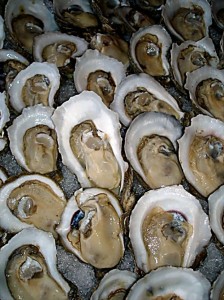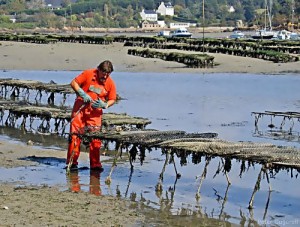Oyster or talaba is a marine mollusks having a rough irregular shell mostly found in coastal waters. Oyster has a grayish-white color and are commonly consumed by humans, cooked or raw. It is mostly marketed in the shell as freshly-shucked meat. Some salted oyster or bagoong are made during peak harvest season. It is rich in vitamins, minerals, proteins and carbohydrates. The shells are mostly used as raw materials for the manufacture of lime and poultry grit. The shells also serve as spat collectors for culturing.
Oyster culture in the Philippines began at Hinigaran, Negros Occidental, in 1921. Mariculture of oysters have been expanding to other areas in the past years. There are about 5 sq km used for oyster culture ranging from 1,500 m-5,000 sq m in about 1,300 farms. Oyster farms are located in 17 provinces comprising Regions I, IV and VI. Major producers are Negros Occidental, Pangasinan and Cavite. There are little or no available records of oyster preparation exports and data on consumption. Oysters are mostly consumed near production areas.

Site selection
Oysters thrive best in brackish to marine waters with salinity ranging from 15-26 ppt at 20-30ºC water temperature. Viable oyster farming grounds have indigenous species of spawners that are present. The water should be free from pollution with green to blue-green color. The area should be free from flooding that may result to 0-10 ppt salinity; this causes heavy mortality and heavy siltation. Water depth should be at least 1.5-4.0 m at the lowest tide.
The bottom is either hard non-shifting or soft and muddy. Areas for culture must be naturally protected against strong wind and wave action along landlocked bays or estuaries. Materials for structures should be readily available and cheap. Preferably, sites should be near markets or centers of population within 100 km. The presence of endemic seeds or spats in the area is preferred, but seeding or transplanting of oysters may be undertaken.
Culture aspects
How to culture Oyster (Talaba):
There are four popular species of oyster for culture:
- Crasostrea iredalei (Talabang tsinelas or slipper-shaped)
- Saccostrea malabonensis (Kukung kabayo or oblong)
- palmipes (Pulid-pulid or palm-rooted)
- cucullata (Kulot or wild oyster)
The first two species are recommended for growing.
Peak natural spatting season or spawning usually occurs in January to February and May to September. Fertilization of spawned oyster eggs takes place in the water. After hatching, a planktonic larva emerges and remains in the waters for two to three weeks before settling down. Spats or seeds about the size of sand grain attach to suitable substrates (like logs, stones, shells, bottoms, etc.). The most suitable and commonly used spat collectors are empty oyster shells.
After a growth period of one month, the juvenile oysters (young) measure about 1.27 cm long. Oyster food consists of microorganisms, phytoplankton and organic matter which they strain or filter out from the water with their gills. This explains why oysters thrive well in fertile waters. It normally matures after 6-10 months from seeding.
Culture period should be started before spatting season or spat fall. Juvenile oysters can be transplanted to other areas with no available spats.

Methods of culture
There are several methods of culture: stake (tulos), hanging (pabitin), long line (sampayan) or stone (paringit). However, the hanging method is recommended.
The hanging method is constructed by piling a 3.04.0 m bamboo post or 7.6212.70 cm diameter wooden post at 4.0 meter distance in between rows and 1.0-1.5 m between rows. The rows should be 8 m long (the normal length of hard bamboo) and the number of rows should be ten per lot. In-between rows are lanes of at least 2-3 m for the caretaker’s dugout wooden boat to pass. Bamboo pole platforms are tied to the post at about 0.50 m below zero tide level. Threaded empty oyster shells ranging from 12-16 pieces at a distance of 7.62-10.16 cm in-between shells or clutches serve as the spat collectors. Use No. 3 or 4 polyethylene ropes or plastic twines. The threaded cultches are then hung at the bamboo pole platforms. Maintain, 20.0-25.0 cm distance between substrates or cultches.
Maintenance
- Check the structure for damage and promptly replace damaged parts, where appropriate.
- Set the hanging oysters just below the normal low tide level.
- Remove sponges growing on the surface of the oysters. They impede the flow of water and food as well as compete for oxygen and food.
- It is desirable to construct a caretaker’s hut in the farm to deter potential poachers and to facilitate management of the farm.
Harvesting
Not much care is needed in oyster farming, except by guarding it from poachers through frequent visits or by staying at the site two to three months before harvest . Harvesting is done by pulling the hanging cultch lines. Separate the bigger oysters for market and leave the small ones at the bottom bamboo tray to grow further. Submerge and clean harvested oyster shells. Pack them in gunny sacks or bamboo baskets or kaing. The bamboo basket contains about 40 kg fresh shell oysters. The marketable size is 6.0-12.50 cm long. Oysters are best harvested before the spatting season of March to May because they are fat and delicious during summer (dry months).
Production can reach 8-12 metric tons per hectare. A family-sized growing area of 2,500 sq m is an ideal, livelihood project for beginners.
In areas where there is an occurrence of red tide that cause poisoning to humans, harvesting should be suspended or stopped until the area is cleared or free from red tide organisms.
Source: The Science and Business of Growing Oysters, PHRDC, 1991, Photo: Wikimedia Commons and yovia.com